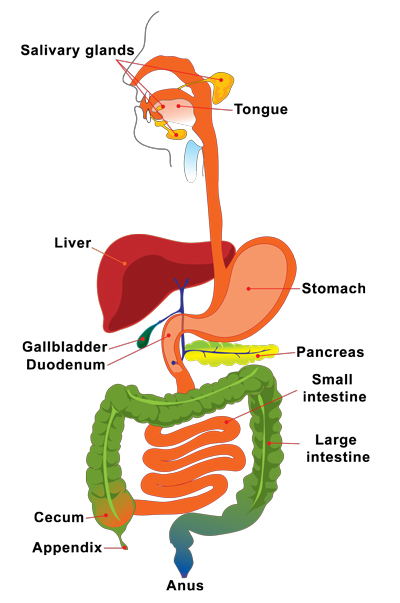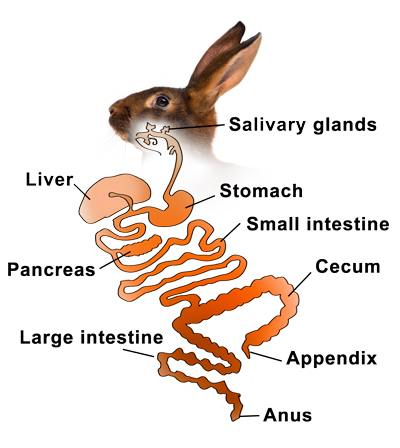The appendix
Functional, but still evidence for evolution?
 ©123rf.com/sciencerf
©123rf.com/sciencerfOur digestive system is one of God’s amazing designs. It starts in the mouth where food is chewed and mixed with enzyme-rich saliva which breaks down starch. In the stomach, more digestive enzymes are added as the contents are churned by the stomach muscles.
The next stage is the small intestine where most digestion and absorption of nutrients takes place. From there, waste products move to the large intestine where water is removed before exiting the body.
Where our large and small intestines meet, there is a pouch known as the ‘cecum’ or ‘caecum’—from Latin, caecus meaning ‘blind’ (fig. 1). In humans this is quite small, but in herbivores such as rabbits it is much larger, and contains bacteria which are specially suited to digesting plant material (fig. 2).
In humans and some other mammals, there is a worm-shaped appendage, protruding from the cecum, known as the appendix (also called the ‘vermiform appendix’ or ‘cecal appendix’). Charles Darwin argued that this was a ‘vestigial organ’, a useless remnant of something that our distant ancestors used way back in our evolutionary history, when we supposedly ate mostly vegetation such as leaves. As our diet changed, our digestive system supposedly evolved, causing a previously much larger cecum to shrink, leaving a useless remnant in the form of the appendix.1
Vestigial organs are not evidence for evolution
The appendix is just one of many organs once commonly claimed by evolutionists to be useless leftovers from our evolutionary past. Over the years, however, the list of ‘vestigial organs’ has become shorter and shorter, as scientists have discovered their functions. Some evolutionists now doubt whether any genuine examples exist.2 Moreover, even if an organ were to be proven redundant, all this would demonstrate is that organs and functions can be lost; but evolutionists need to show that they can be gained! That is, they need to demonstrate nascent organs: those increasing in complexity.

In the case of our appendix, evidence of its importance has been emerging slowly, as medical scientists have learnt more and more about the body and how it functions. Inside our gut, mainly in the large intestine, there are trillions of ‘good’ bacteria that are essential to its proper function. For example, they help with digestion, and some also generate vitamins B and K. Indeed, the human body usually has more bacterial cells than human cells!3 The lining of the appendix is specially adapted to nurture such friendly microbes, producing special proteins that clump bacteria together and bind them to a mucus layer.4,5 Tucked away inside a narrow cul-de-sac, isolated from gut infections, they thrive in this ‘safe house’, ready to recolonize the intestine when needed—for example, following a bout of diarrhea.
The large intestine is normally coated with ‘good’ bacteria that help prevent ‘bad’ bacteria passing through the intestinal wall and entering body tissues. Diarrhea can clear this protective barrier (biofilm) from the gut lining. It is thought that the bacteria required to recreate this protective layer might be provided exclusively by the appendix, as this is the only place where the required bacteria remain unharmed.5
Clostridium difficile is a ‘bad’ bacterium that can cause a nasty (even fatal) infection of the gut. One study indicated that people whose appendix had been removed were four times more likely to suffer a recurrence of this illness.6 Also, research has shown an increased incidence of various gastro-intestinal cancers among those who have had an appendectomy.7

More recently it has been argued that the body uses bacteria to stimulate the development of the intestine’s immune system soon after birth, and research has suggested that the appendix may play a crucial role in this.5
According to immunologist Professor Gabrielle Belz, rather than the appendix being a useless vestige, it seems likely that it is, in fact, “an integral part of the immune system.”8 Other experts have explicitly concluded: “… the idea of the appendix being a vestigial organ should therefore be discarded.”5
A new twist in the story
Professor Jerry Coyne is an evolutionary biologist at the University of Chicago, an atheist and a prominent critic of creationists. Along with an increasing number of his colleagues, he now concedes that the appendix is, indeed, functional. However, he still maintains that it is a ‘vestige’ and therefore evidence for evolution. He argues,
“[I]f a feature is an evolutionary modification of an obviously ancestral feature … then it can be both useful and vestigial, and therefore testimony of evolution.”9
However, if Coyne is right, then every organ should be considered vestigial as, in the thinking of evolutionists, every feature in every animal has evolved from something else. Hence, according to Coyne’s new definition, human arms and bird wings would also be vestigial because they supposedly evolved from the legs of reptiles. Moreover, nowhere in his blog does he attempt to demonstrate that the appendix did evolve from an ancestral feature. Rather he just assumes this, considering it to be obvious.
An obvious remnant of a digestive organ?
Increasingly, evolutionists are questioning Darwin’s hypothesis that the appendix is the remnant of a much reduced cecum. Assuming the textbook evolutionary history of mammals, researchers found no correlation between supposed changes in diet and either the presence or size of an appendix. In addition, across mammals generally, there is no trend associating the presence of an appendix with a small cecum; rather a large appendix is often associated with a large cecum.10 Hence some evolutionists have concluded that the appendix evolved originally as a bacterial safe-house. Moreover, because of the lack of any possible overall pattern of common ancestry for the appendix, they have asserted that it “must have evolved independently [in different evolutionary lines] at least 32 times, and perhaps as many as 38 times.”11
Why is it sometimes necessary to remove the appendix?
Sometimes the appendix can become blocked, for example, by a hard mass of fecal matter, causing it to become infected. This is known as appendicitis. People groups that include a lot of roughage in their diet tend to have a low incidence of appendicitis, which is probably one of the reasons that, had humanity not sinned, we would never have had this problem. In the perfect world that God originally created, and with His intended diet, our bodies would have worked perfectly.
Though surgical removal of an inflamed appendix remains a mainstay of treatment, there is increasing evidence that a course of antibiotics may be sufficient to solve the problem.12 This should, of course, be under close medical supervision because, if unresponsive to conservative treatment and not removed in time, the appendix can burst, contaminating the abdominal cavity—a life-threatening and often fatal medical emergency.13 This may be one reason why even healthy appendixes have been removed ‘incidentally’ (i.e. while patients were undergoing other surgery ‘nearby’), simply as a precautionary measure—a practice which, no doubt, would have been reinforced by the belief that it was a useless leftover from evolution.14

While it would be very foolish to ignore medical advice that an appendix be removed, it seems clear that many people with a mild case of inflammation, or even none, have had it removed unnecessarily. Since the appendix is now known to be functional, with some of this function still present in adults, and since surgery itself is not without risk, some doctors are now advocating a more cautious approach.
However, it has taken many years for the medical profession to begin to reach this point. Hence, it would seem that, yet again, the evolutionary paradigm has simply delayed the progress of medical science. Having been told that the appendix is nothing more than an evolutionary vestige, there was little motivation to study it. Had more doctors believed the Bible’s teaching—that people were made specially and supernaturally by God—they would surely have learnt of the appendix’s function many years ago, and would have been less eager to remove it.
References and notes
- Darwin, C.R., The Descent of Man and Selection in Relation to Sex, vol. 1, John Murray, London, pp. 27 and 206, 1871. Return to text.
- Scadding, S.R., Do ‘vestigial organs’ provide evidence for evolution? Evolutionary Theory 5:173–176, 1981. Return to text.
- While many have claimed a 10:1 ratio of bacterial to human cells, the ratio is closer to 1:1. E.g. a 70 kg man has ~30 trillion human cells and ~40 trillion bacteria—see Abbott, A., Scientists bust myth that our bodies have more bacteria than human cells: Decades-old assumption about microbiota revisited, Nature, 8 January 2016 | doi:10.1038/nature.2016.19136. Return to text.
- In the appendix, there is an overall high density of the glycoprotein mucin and the immunoglobulin sIgA produced by B cells in the mucosa, making this a strongly promicrobiotic environment. Return to text.
- Kooij, I.A. et al., The immunology of the vermiform appendix: a review of the literature, Clin. Exp. Immunol. 186(1):1–9 October 2016 | doi:10.1111/cei.12821/full. Return to text.
- Dunn, R., Your appendix could save your life, Sci. Am., 2 January 2012; blogs.scientificamerican.com. Return to text.
- Wu, S. et al., Association between appendectomy and subsequent colorectal cancer development: An Asian population study, PLoS One 10(2):e0118411, 2015; ncbi.nlm.nih.gov. Return to text.
- Rosenfeld, J., Immunology study suggests the appendix has a use after all, 12 January 2016; mentalfloss.com. Return to text.
- Coyne, J.A., Is the appendix a vestigial organ? 15 May 2016; whyevolutionistrue.wordpress.com. Return to text.
- Smith, H.F.et al., Multiple independent appearances of the cecal appendix in mammalian evolution and an investigation of related ecological and anatomical factors, C. R. Palevol 12(6):339–354, 2013 | doi:10.1016/j.crpv.2012.12.001. Return to text.
- Barras, C., Appendix evolved more than 30 times, ScienceNOW, sciencemag.org, 12 February 2013. See also Catchpoole. D., Appendix affirms creation (at least 18 times), Creation 38(2):12–14, 2015; creation.com/appendix4. Return to text.
- Hall, N.J. et al., Active observation versus interval appendicectomy after successful non-operative treatment of an appendix mass in children (CHINA study): an open-label, randomised controlled trial, Lancet 2(4):253–260, April 2017 | doi:10.1016/S2468-1253(16)30243-6. Return to text.
- Peritonitis leading to septicemia (bloodstream infection), which can rapidly overwhelm the body’s defences even with the most powerful antibiotics. Return to text.
- Snyder, T.E. and Selanders, J.R., Incidental appendectomy—Yes or No? A retrospective case study and review of the literature, Infect. Dis. Obstet. Gynecol. 6:30–37, 1998; ncbi.nlm.nih.gov. Return to text.



Readers’ comments
Comments are automatically closed 14 days after publication.